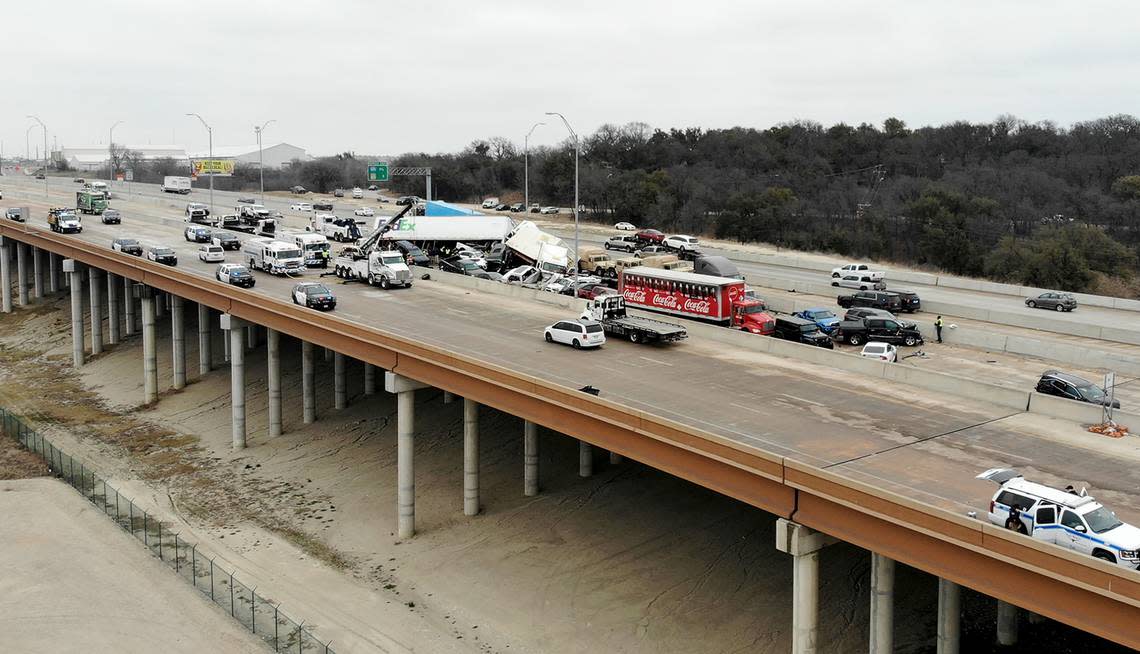Average speeds topped 100 before 133-vehicle pileup on icy I-35W in Fort Worth: Report

The average speed exceeded 100 mph on Interstate 35W just as it began to rain before a deadly February 2021 pileup that killed six, according to the North Tarrant Express Mobility Partners.
The National Transportation Safety Board released hundreds of pages of documents on Wednesday related to its investigation into a 133-vehicle crash on an icy patch of southbound TEXPress lanes near Northside Drive in Fort Worth. The report included a document submitted by the toll road operators.
The board, an independent federal agency that investigates transportation accidents, will issue a final report that includes an analysis of the documents released Wednesday, information about a probable cause of the crash and prevention recommendations, a spokesperson said in an email. That report is expected in late winter or early spring.
The board in April 2021 released a preliminary report that found the company responsible for preventing ice on the TEXPress lanes had applied a brine solution to the roadway 44 hours before the crash, which occurred at about 6 a.m.
According to the document from Mobility Partners, the average vehicle speed was 65 mph in the right lane and 82 in the left 15 minutes before the collision, but speeds topped 100 mph at one point less than 15 minutes before the accident.
Concrete barriers separate the toll lanes, where the speed limit is 75 mph. The roadway has a left shoulder of about 4 feet and a right shoulder of about 10 feet.
At the time of the collision, signs 1.9 miles and 3 miles from the crash site indicated that bridges may ice in cold weather, according to a report from NTSB officials. Additional dynamic message signs warned of ice on roads.
Documents made public Wednesday include transcripts of witness interviews, a meteorological report and photos from the accident scene.
Robert Hinkle, a spokesperson for North Tarrant Express Mobility Partners, confirmed receipt of the various reports related to NTSB’s investigation.
“Our team will be reviewing these documents, and we look forward to continuing to cooperate with the NTSB as it concludes its investigation and releases its final report,” Hinkle said in an email, declining to comment further.
Timeline leading up to the deadly crash
The compilation of documents includes a timeline of the days leading up to the crash, and outlines where and when roads were treated to prevent ice.
Feb. 9, 2021 at about 10:12 a.m.: North Tarrant Express Mobility Partners applies brine solution to the southbound toll lanes.
Feb. 11, 2021 at about 3 a.m.: A crash occurs on the northbound general use lanes of I-35W, about five miles north of the crash site. The crash was partially due to icy conditions on an elevated bridge, according to the report.
Feb. 11., 2021 at about 3:20 a.m.: North Tarrant Express Mobility Partners dispatches maintenance crew members to the northbound crash site. They used salt to “spot treat” southbound and northbound toll lanes and general use lanes — a process that was complete around 4:43 a.m. Around 3:40 North Tarrant Express Mobility Partners also activated seven dynamic message signs within 8.3 miles of the crash.
Feb. 11., 2021 at about 4:40 a.m.: North Tarrant Express Mobility Partners detect moisture near the area where the crash later occurred and send maintenance crew members to treat the U.S. 287 entrance ramps to northbound toll lanes and general use lanes, and the Texas 280 entrance ramps to northbound and southbound general use lanes with salt. Treatment was done at about 5:20 a.m.
Feb. 11., 2021 at about 6 a.m.: The pileup crash occurs in the southbound I-35W toll lanes near the exit to Northside Drive.
What preventative measures have been taken?
According to the documents, North Tarrant Express Mobility Partners has taken a number of steps since the 2021 crash, including training updates and increasing the number of vehicles available for maintenance. Also among the changes, salt storage has been increased by more than 400 tons, they’ve added a new weather forecast vendor to give forecasts that are more localized and added sensors to capture air and pavement temperatures.
The toll road operator is asking the NTSB to find that it properly treated roads for ice and is recommending the American Association of State Highway and Transportation Officials study a way to encourage drivers to reduce their speed in hazardous weather.
This is a developing story. Check back for updates.
